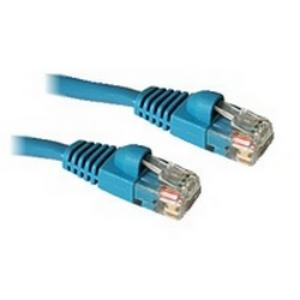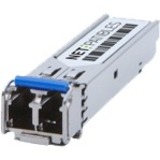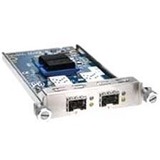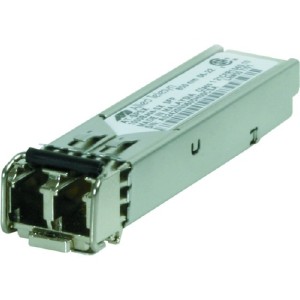Allied Telesis AT-SPSX SFP (mini-GBIC) Module - For Data Networking, Optical Network - 1 x LC 1000Base-SX Network - Optical Fiber - 62.5/125 µm, 50/125 µm - Multi-mode - Gigabit Ethernet - 1000Base-SX - 1.25 Gbit/s - 1804.46 ft Maximum Di AT-SPSX-90
AT-SPSX-90 | Allied Telesis®
Part Number: AT-SPSX-90
Condition: New
In Stock: 965
Real time availability 
Product Specifications
Allied Telesis AT-SPSX SFP (mini-GBIC) Module - For Data Networking, Optical Network - 1 x LC 1000Base-SX Network - Optical Fiber - 62.5/125 µm, 50/125 µm - Multi-mode - Gigabit Ethernet - 1000Base-SX - 1.25 Gbit/s - 1804.46 ft Maximum Di AT-SPSX-90
TAA (FEDERAL) SFP/LC 1G, MULTI-MODE, 220M/550M, 850NM
Manufacturer Part Number: AT-SPSX-90
MANUFACTURER NAME: Allied Telesis
MANUFACTURER PART NUMBER: AT-SPSX-90
UPC EAN CODE: 767035173276
LANGUAGE: EN
MARKET:US
| General Information: | |
The AT-SPSX offers a short-haul option to extend your network to 550m The AT-SPSX is compatible with all the Allied Telesis range of products which have an SFP port. | |
| Manufacturer | Allied Telesis, Inc |
| Manufacturer Part Number | AT-SPSX-90 |
| Manufacturer Website Address | http://www.alliedtelesis.com |
| Brand Name | Allied Telesis |
| Product Series | AT-SP |
| Product Model | AT-SPSX |
| Product Name | AT-SPSX SFP (mini-GBIC) Module |
| Product Type | SFP (mini-GBIC) |
| Product UPC | 767035173276 |
| Technical Information: | |
| Application/Usage | Data Networking
Optical Network |
| Interfaces/Ports: | |
| Total Number of Ports | 1 |
| Connector Type | LC |
| Interfaces/Ports Details | 1 x LC 1000Base-SX Network |
| Media & Performance: | |
| Media Type Supported | Optical Fiber |
| Fiber Optic Cable Standard | 62.5/125 µm
50/125 µm |
| Fiber Mode Supported | Multi-mode |
| Ethernet Technology | Gigabit Ethernet |
| Network Technology | 1000Base-SX |
| Maximum Distance Supported | 1804.46 ft |
| Maximum Data Transfer Rate | 1.25 Gbit/s |
| Physical Characteristics: | |
| Form Factor | Hot-swappable |
| Miscellaneous: | |
| Country of Origin | Taiwan |
| Environmentally Friendly | Yes |
Questions and Answers
Questions and Answers | Ask CompSource |
Shipping / Returns
Shipping
Ground =
$12.95
(EST. Arrival Date between
Wed.Nov.20 - Mon.Nov.25)
Two Day Air = $25.00
(EST. Arrival Date on Wed.Nov.20)
Standard One Day = $35.00
(EST. Arrival Date on Tue.Nov.19 after 3PM)
Priority = $45.00
(EST. arrival Date on Tue.Nov.19 in the AM)
U.S Mail Priority (AA,AE,AP only) = $30.00
FedEx International Economy (Canada only) = $85.00
Shipping dates are best estimates based on product location and may vary with holidays.
If product requires trucking, additional fees may apply.
* Some destinations are subject to Applicable State/Duty Taxes
Returns
CompSource realizes that every product may have different return guidelines. Please see the policy below regarding this item.
This Product Has Limited Exchange Privileges.
Limited returns within 30 days of purchase permitted on this product.
For support on this product, please contact Allied Telesis. 1.800.424.6596 WWW.ALLIEDTELESIS.COM
Allied Telesis Company's Information
Click Allied Telesis for all products
Local #: (425)481-3714
Toll Free #: 1.800.424.6596
Site: WWW.ALLIEDTELESIS.COM
Product Reviews
Overall Rating | Write a Review
|
|
Best Sellers
More Best Sellers
Rebates
More Rebates
Recently Viewed
Learn more about Switch Modules
Switches, routers, and wireless access points
Switches, routers, and wireless access points perform very different functions in a network.
A computer network, or data network, is a digital telecommunications network which allows nodes to share resources. In computer networks, computing devices exchange data with each other using connections (data links) between nodes These data links are established over cable media such as wires or optic cables, or wireless media such as WiFi.Switches
Switches are the foundation of most business networks. A switch acts as a controller, connecting computers, printers, and servers to a network in a building or a campus.
Switches allow devices on your network to communicate with each other, as well as with other networks, creating a network of shared resources. Through information sharing and resource allocation, switches save money and increase productivity.
There are two basic types of switches to choose from as part of your networking basics: managed and unmanaged.
- An unmanaged switch works out of the box but can't be configured. Home-networking equipment typically offers unmanaged switches.
- A managed switch can be configured. You can monitor and adjust a managed switch locally or remotely, giving you greater control over network traffic and access.
Routers
Routers connect multiple networks together. They also connect computers on those networks to the Internet. Routers enable all networked computers to share a single Internet connection, which saves money.
A router acts a dispatcher. It analyzes data being sent across a network, chooses the best route for data to travel, and sends it on its way.
Routers connect your business to the world, protect information from security threats, and can even decide which computers receive priority over others.
Beyond those basic networking functions, routers come with additional features to make networking easier or more secure. Depending on your needs, for example, you can choose a router with a firewall, a virtual private network (VPN), or an Internet Protocol (IP) communications system.
Access points
An access point* allows devices to connect to the wireless network without cables. A wireless network makes it easy to bring new devices online and provides flexible support to mobile workers.
An access point acts like an amplifier for your network. While a router provides the bandwidth, an access point extends that bandwidth so that the network can support many devices, and those devices can access the network from farther away.
But an access point does more than simply extend Wi-Fi. It can also give useful data about the devices on the network, provide proactive security, and serve many other practical purposes.
*Access points support different IEEE standards. Each standard is an amendment that was ratified over time. The standards operate on varying frequencies, deliver different bandwidth, and support different numbers of channels.
Wireless networking
Wireless networking is a method by which homes, telecommunications networks and business installations avoid the costly process of introducing cables into a building, or as a connection between various equipment locations.CompSource will educate and help make this process enjoyable and easy.
Whether you're planning on using your network for basic home tasks or enterprise level security. You can tell our trained sales professionals your needs, and we'll make custom recommendations to suit your specifications and budget. Our reps have extensive knowledge and love to share. We educate, not sell, CompSource makes sure you buy what you need and not waste money on what you don't. As with every decision we never push, it's up to you when, and if you make a purchase.
CompSource has a great technical staff that can help with a solution for your exact needs.
Chat with us or give our professionals a quick phone call (800)-413-7361.
Just wanted to say how impressed I am with your service. Received the correct order in record time for the right price. I will highly recommend your business to anyone. I will rate you on your Web site Thanks again Bob N. Lead system Administrator Bob N.More Reviews

























